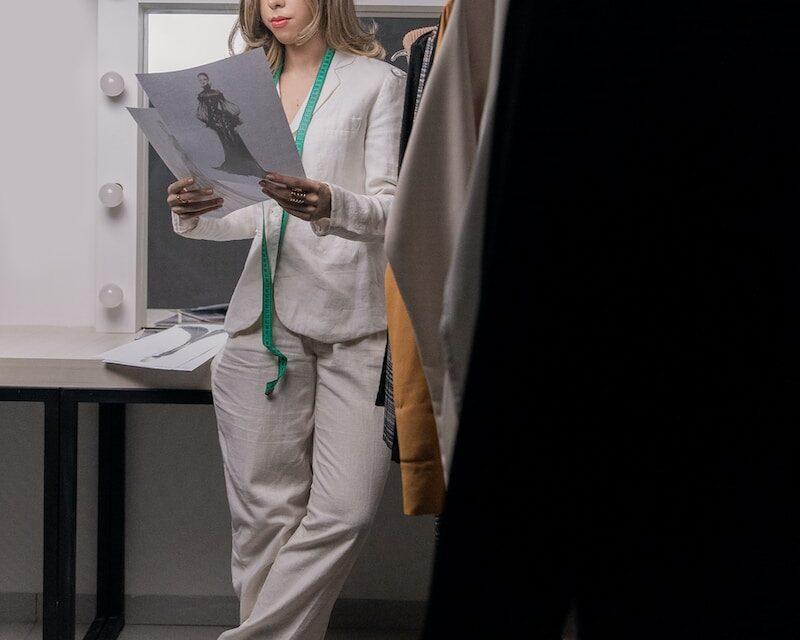Fashion design is an exciting and dynamic field that has captured the world’s attention for centuries. From haute couture to street style, clothing designers have played a significant role in shaping how people dress and express themselves. In today’s highly competitive fashion industry, designers are not only known for their creativity but also their earning potential.
A Fashion designers’ earnings or salary varies significantly depending on various factors such as experience, location, and employer. Fashion designers can work for large companies or create their own brands and work as freelancers.
They can specialize in different areas such as clothing, footwear, bags, or accessories. The earnings of fashion designers are determined by the demand for their skills and the level of competition in the market.
The Importance of Fashion Designers in the Industry
Fashion is not just about dressing well; it is an art that involves creating designs that reflect cultural trends and individual preferences. Fashion plays a vital role in society by influencing people’s perceptions of themselves and others. A good fashion designer uses fabrics, colors, textures, and patterns to create unique designs that inspire confidence and self-expression.
Fashion designers are at the forefront of this creative process by translating ideas into tangible products that consumers can buy and wear. Without these talented individuals’ contributions to the industry, we wouldn’t have access to innovative styles or new trends each season.
Factors That Determine a Fashion Designer’s Salary
Several factors contribute to determining a fashion designer’s salary. One essential factor is experience – experienced designers who have worked with reputable companies command higher salaries than entry-level ones due to their seasoned skills. Location also plays a significant role in determining how much a fashion designer earns since regions with higher costs of living typically pay more than areas where things are cheaper.
Therefore it is no surprise that New York City-based designers earn more on average than those based in rural areas. The employer or client a designer works with determines their salary.
Renowned brands and luxury fashion houses pay higher rates than small, unknown companies or startup brands. Freelancers, who create designs for clients on an individual basis, typically earn more than full-time employees at established companies.
The earning potential of a fashion designer can be highly lucrative if one possesses creativity and skillset that people are willing to pay for. However, it is essential to keep in mind that factors such as experience, location and employer play a vital role in determining how much they earn.
Average Salary or Fashion Designers’ Earnings
Fashion design is a highly competitive and lucrative career that requires creativity, skill, and dedication. According to recent statistics, the average salary of fashion designers varies depending on several factors such as experience, location, and employer.
In this section of the article, we will explore these factors in more detail. Experience: Experience plays a significant role in determining a fashion designer’s salary.
Generally, designers who have been in the industry longer tend to earn higher salaries than those just starting. According to the Bureau of Labor Statistics (BLS), the median annual wage for fashion designers was $77,450 per year as of May 2021.
However, entry-level designers may make less than this amount. Location: Location is another important factor that determines how much a fashion designer earns.
The cost of living varies from one region to another, and salaries also reflect that difference in cost. For example, New York City is known for its high cost of living; therefore, fashion designers working there typically earn higher salaries than those working elsewhere in the country.
Employer: The type of employer that a fashion designer works for also affects their salary. Typically, larger companies with bigger budgets pay higher salaries than smaller or independent companies.
Moreover, different sectors like apparel manufacturing and wholesale trade employ more people than other sectors such as motion picture or video industries. While there are many variables that determine a fashion designer’s salary including education level or niche expertise within design fields (shoes or bags) experience level is considered one of the most significant factors influencing earnings potential within any given category mentioned above (apparel manufacturing or wholesale trade).
High-Paying Jobs in Fashion Design
The Power of the Creative Director
When it comes to high-paying jobs in fashion design, the role of creative director is often at the top of the list. This position is responsible for leading the overall creative vision for a brand or company.
Creative directors work closely with designers, marketers, and other key players to create cohesive collections that resonate with consumers. The reason why creative directors command higher salaries than other positions is because they are responsible for the overall success of a brand’s collections.
They are also responsible for managing large teams and ensuring that everyone works together seamlessly to meet deadlines and create outstanding designs. For example, Raf Simons, former artistic director at Dior, reportedly earned over $1 million per year in salary alone during his time there.
The Head Designer’s Role
Another high-paying job in fashion design is head designer. This role involves overseeing all aspects of product design and development.
Head designers work closely with pattern makers and sample makers to ensure that products meet specifications and are produced on time. Head designers can earn high salaries because they are responsible for creating designs that not only look good but also sell well.
Companies rely on their head designers to create collections that will resonate with customers and drive sales. The head designer at Chanel reportedly earns around $10 million per year!
Other High-Paying Roles
In addition to creative directors and head designers, there are many other high-paying roles in fashion design. Some examples include textile designers, who create patterns and prints used in clothing; visual merchandisers, who design store displays; and fashion buyers, who purchase products for retail stores.
These roles command higher salaries because they require specialized skills and knowledge of the industry. For example, textile designers must have a strong understanding of fabrics and printing techniques in order to create unique designs.
Fashion buyers must have a keen sense of what will sell well in stores and negotiate with suppliers to get the best prices. The fashion design industry offers a range of high-paying jobs for those with the talent, drive, and skills to succeed.
Creative directors, head designers, and other specialized roles are highly sought after and can command six-figure salaries or more. Whether you’re interested in designing clothing or creating eye-catching store displays, there’s always room for talented individuals in this exciting field.
Freelance vs. Full-Time Employment
Earning Potential
One of the biggest differences between freelance and full-time employment in fashion design is earning potential. As a freelancer, you have the ability to set your own rates and take on as many clients as you can handle. This means that you have the potential to earn more money than someone who works for a company with a fixed salary.
However, freelance work can also be unpredictable. There may be times when you have more clients than you can handle, but there may also be times when work is scarce.
On the other hand, working for a company often comes with a guaranteed salary and benefits package. While this may not offer as much flexibility as freelancing, it does provide some stability.
Benefits and Drawbacks
There are pros and cons to both freelance and full-time employment in fashion design. Freelancing allows you to have more control over your schedule and workload, but it also requires self-discipline and strong time-management skills.
Full-time employment provides stability and benefits, but it may also come with less creative freedom due to having to follow company guidelines. Another benefit of freelancing is that you have the potential to work on a wider variety of projects for different clients, which can help expand your skillset and portfolio.
However, working for one company allows for a deeper understanding of their brand identity and aesthetic. Ultimately, whether freelance or full-time employment is better suited for an individual depends on their personal preferences, financial goals, and career aspirations.
Both freelance work and full-time employment offer opportunities for fashion designers to earn a living in their field. Each option has its own unique advantages and disadvantages that should be carefully considered before making a decision. For those who value flexibility and independence in their work schedule, freelancing may be the way to go.
However, those who prioritize stability and benefits may prefer a full-time position. Regardless of the choice, it is important to continue honing your skills and building your portfolio to ensure continued success in the competitive field of fashion design.
Additional Income Streams for Fashion Designers
Expanding Revenue Beyond Traditional Employment
In addition to their regular job as a fashion designer, there are many ways that they can earn extra income. Freelancing is a popular avenue, allowing designers to create designs for various clients and earn a fee for each project.
This allows them to work at their own pace and set their own rates, giving them the flexibility to work on projects they truly enjoy. Many fashion designers also turn to selling designs online through platforms like Etsy or Shopify.
This allows them to reach a wider audience and sell unique, one-of-a-kind pieces without the limitations of traditional retail channels. Designers who are able to build a strong following on social media can leverage that influence by collaborating with brands or promoting products for companies in exchange for compensation.
Successful Designers Who Have Diversified Their Income Streams
Several successful fashion designers have taken advantage of these alternative revenue streams. Alexander McQueen was an early adopter of perfume licensing deals, which helped him expand his brand beyond just clothing and accessories. Victoria Beckham has diversified her career from popstar to fashion designer by building an online store where customers can purchase her clothing line.
Zac Posen has collaborated with Mattel on Barbie dolls wearing his designs. Another example is Christian Siriano who has diversified his income streams in several ways such as designing costumes for stage productions like Disney’s The Little Mermaid Live!
In Concert; producing mass-market collections in partnership with Payless shoes and Lane Bryant; designing exclusive collections sold at Neiman Marcus stores; appearing on reality TV series “Project Runway”; writing books about fashion design; collaborating with beauty brand e.l.f Cosmetics among other ventures. With creativity, drive and hard work, there are endless ways that fashion designers can increase their earning potential while also expanding their brand and growing their business.
Factors That Affect Earnings Potential
Education Level
When it comes to earning potential, education plays a crucial role in the fashion industry. Most designers have at least a bachelor’s degree in fashion design or a related field, and those with advanced degrees tend to earn more. In addition to providing technical skills and design knowledge, higher education can also help designers build their professional network, which can lead to more lucrative job opportunities.
Skillset
A designer’s skillset is another important factor that affects their earning potential. Designers who specialize in niche areas such as bridal or haute couture tend to earn more than those who work in mass-market fashion. Additionally, designers who are proficient in multiple areas such as sketching, pattern-making and garment construction are often highly sought after by employers.
Industry Demand
The overall demand for fashion designers heavily impacts their salary potential. When the economy is strong and consumer spending is up, demand for designers tends to increase along with salaries. However, when the economy slows down or there are shifts in consumer spending habits (such as during a pandemic), demand for designers may decrease and salaries may be affected.
Highlight Ways That Aspiring Designers Can Increase Their Chances of Earning
Aspiring fashion designers looking to increase their earning potential should focus on building their skills and experience through internships, apprenticeships or entry-level positions within the industry. Pursuing additional education or training can also be valuable for improving technical skills and building relationships within the industry.
Networking is also critical for aspiring designers looking to increase their chances of earning a higher salary. Attending industry events such as trade shows or conferences can help build professional connections that may lead to future job opportunities or collaborations.
It’s important for aspiring designers to focus on developing a unique and marketable design aesthetic. Designers who can differentiate themselves from the competition with a fresh perspective or innovative approach are more likely to stand out to employers and command higher salaries.
Conclusion
There are many factors that contribute to a fashion designer’s earning potential, including education level, skillset and industry demand. Aspiring designers can take steps to improve their chances of earning higher salaries by building their skills and experience, networking within the industry and developing a unique design aesthetic.
While the fashion industry can be competitive and challenging, those who are passionate about design and willing to put in the work have the potential to build successful careers with lucrative earnings. By staying up-to-date on industry trends and continuously improving their skills, designers can position themselves for long-term success in this exciting field.












